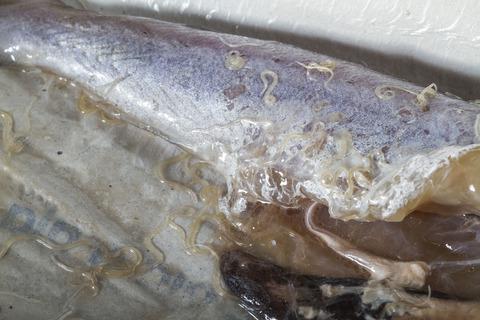当前位置:
X-MOL 学术
›
Glob. Change Biol.
›
论文详情
Our official English website, www.x-mol.net, welcomes your feedback! (Note: you will need to create a separate account there.)
It's a wormy world: Meta-analysis reveals several decades of change in the global abundance of the parasitic nematodes Anisakis spp. and Pseudoterranova spp. in marine fishes and invertebrates.
Global Change Biology ( IF 11.6 ) Pub Date : 2020-03-19 , DOI: 10.1111/gcb.15048 Evan A Fiorenza 1 , Catrin A Wendt 1 , Katie A Dobkowski 1, 2 , Teri L King 3 , Marguerite Pappaionou 4 , Peter Rabinowitz 4 , Jameal F Samhouri 5 , Chelsea L Wood 1
Global Change Biology ( IF 11.6 ) Pub Date : 2020-03-19 , DOI: 10.1111/gcb.15048 Evan A Fiorenza 1 , Catrin A Wendt 1 , Katie A Dobkowski 1, 2 , Teri L King 3 , Marguerite Pappaionou 4 , Peter Rabinowitz 4 , Jameal F Samhouri 5 , Chelsea L Wood 1
Affiliation

|
The Anthropocene has brought substantial change to ocean ecosystems, but whether this age will bring more or less marine disease is unknown. In recent years, the accelerating tempo of epizootic and zoonotic disease events has made it seem as if disease is on the rise. Is this apparent increase in disease due to increased observation and sampling effort, or to an actual rise in the abundance of parasites and pathogens? We examined the literature to track long‐term change in the abundance of two parasitic nematode genera with zoonotic potential: Anisakis spp. and Pseudoterranova spp. These anisakid nematodes cause the disease anisakidosis and are transmitted to humans in undercooked and raw marine seafood. A total of 123 papers published between 1967 and 2017 met our criteria for inclusion, from which we extracted 755 host–parasite–location–year combinations. Of these, 69.7% concerned Anisakis spp. and 30.3% focused on Pseudoterranova spp. Meta‐regression revealed an increase in Anisakis spp. abundance (average number of worms/fish) over a 53 year period from 1962 to 2015 and no significant change in Pseudoterranova spp. abundance over a 37 year period from 1978 to 2015. Standardizing changes to the period of 1978–2015, so that results are comparable between genera, we detected a significant 283‐fold increase in Anisakis spp. abundance and no change in the abundance of Pseudoterranova spp. This increase in Anisakis spp. abundance may have implications for human health, marine mammal health, and fisheries profitability.
中文翻译:

这是一个充满蠕虫的世界:荟萃分析揭示了寄生线虫Anisakis spp在全球范围内数十年来的变化。和Pseudoterranova spp。在海洋鱼类和无脊椎动物中。
人类世已给海洋生态系统带来了巨大变化,但这个年龄是否会带来或多或少的海洋疾病尚不清楚。近年来,流行病和人畜共患疾病事件的节奏加快,似乎疾病正在上升。这种疾病的明显增加是由于增加了观察和取样工作,还是由于寄生虫和病原体数量的实际增加?我们检查了文献,以追踪具有人畜共患病潜力的两个寄生线虫属(Anisakis spp)的长期变化。和伪地球spp。这些带刺的线虫引起该疾病的带刺病,并以未煮熟的生海产品传播给人类。1967年至2017年期间,共有123篇论文符合我们的纳入标准,从中我们提取了755种寄主-寄生虫-定位-年份组合。其中69.7%与Anisakis属有关。和30.3%的人专注于Pseudoterranova spp。元回归显示Anisakis spp增加。丰度(平均蠕虫/鱼)在1962年53年期间,以2015年中没有显著变化Pseudoterranovaspp。从1978年到2015年的37年间有大量的水。对1978-2015年的变化进行标准化处理,以便在属之间进行比较,我们发现Anisakis spp显着增加了283倍。假单胞菌属物种的丰度没有变化。Anisakis spp的增加。丰度可能对人类健康,海洋哺乳动物健康和渔业盈利能力有影响。
更新日期:2020-04-22
中文翻译:

这是一个充满蠕虫的世界:荟萃分析揭示了寄生线虫Anisakis spp在全球范围内数十年来的变化。和Pseudoterranova spp。在海洋鱼类和无脊椎动物中。
人类世已给海洋生态系统带来了巨大变化,但这个年龄是否会带来或多或少的海洋疾病尚不清楚。近年来,流行病和人畜共患疾病事件的节奏加快,似乎疾病正在上升。这种疾病的明显增加是由于增加了观察和取样工作,还是由于寄生虫和病原体数量的实际增加?我们检查了文献,以追踪具有人畜共患病潜力的两个寄生线虫属(Anisakis spp)的长期变化。和伪地球spp。这些带刺的线虫引起该疾病的带刺病,并以未煮熟的生海产品传播给人类。1967年至2017年期间,共有123篇论文符合我们的纳入标准,从中我们提取了755种寄主-寄生虫-定位-年份组合。其中69.7%与Anisakis属有关。和30.3%的人专注于Pseudoterranova spp。元回归显示Anisakis spp增加。丰度(平均蠕虫/鱼)在1962年53年期间,以2015年中没有显著变化Pseudoterranovaspp。从1978年到2015年的37年间有大量的水。对1978-2015年的变化进行标准化处理,以便在属之间进行比较,我们发现Anisakis spp显着增加了283倍。假单胞菌属物种的丰度没有变化。Anisakis spp的增加。丰度可能对人类健康,海洋哺乳动物健康和渔业盈利能力有影响。



























 京公网安备 11010802027423号
京公网安备 11010802027423号